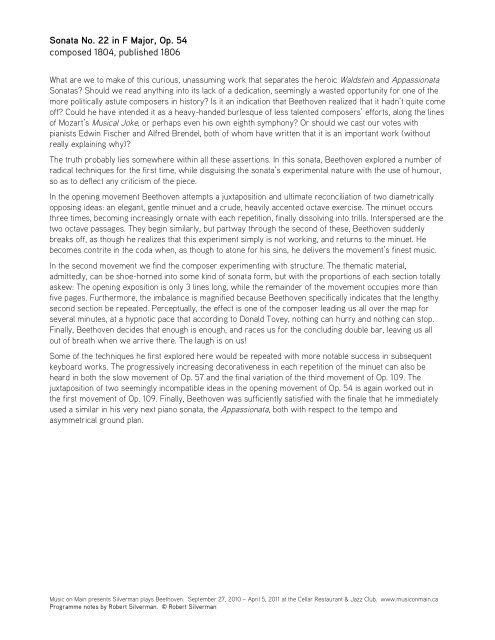beethoven's 32 piano sonatas robert silverman - Music on Main
beethoven's 32 piano sonatas robert silverman - Music on Main
beethoven's 32 piano sonatas robert silverman - Music on Main
Create successful ePaper yourself
Turn your PDF publications into a flip-book with our unique Google optimized e-Paper software.
S<strong>on</strong>ata No. 22 in F Major, Op. 54<br />
composed 1804, published 1806<br />
What are we to make of this curious, unassuming work that separates the heroic Waldstein and Appassi<strong>on</strong>ata<br />
S<strong>on</strong>atas? Should we read anything into its lack of a dedicati<strong>on</strong>, seemingly a wasted opportunity for <strong>on</strong>e of the<br />
more politically astute composers in history? Is it an indicati<strong>on</strong> that Beethoven realized that it hadn’t quite come<br />
off? Could he have intended it as a heavy-handed burlesque of less talented composers’ efforts, al<strong>on</strong>g the lines<br />
of Mozart’s <str<strong>on</strong>g>Music</str<strong>on</strong>g>al Joke, or perhaps even his own eighth symph<strong>on</strong>y? Or should we cast our votes with<br />
pianists Edwin Fischer and Alfred Brendel, both of whom have written that it is an important work (without<br />
really explaining why)?<br />
The truth probably lies somewhere within all these asserti<strong>on</strong>s. In this s<strong>on</strong>ata, Beethoven explored a number of<br />
radical techniques for the first time, while disguising the s<strong>on</strong>ata’s experimental nature with the use of humour,<br />
so as to deflect any criticism of the piece.<br />
In the opening movement Beethoven attempts a juxtapositi<strong>on</strong> and ultimate rec<strong>on</strong>ciliati<strong>on</strong> of two diametrically<br />
opposing ideas: an elegant, gentle minuet and a crude, heavily accented octave exercise. The minuet occurs<br />
three times, becoming increasingly ornate with each repetiti<strong>on</strong>, finally dissolving into trills. Interspersed are the<br />
two octave passages. They begin similarly, but partway through the sec<strong>on</strong>d of these, Beethoven suddenly<br />
breaks off, as though he realizes that this experiment simply is not working, and returns to the minuet. He<br />
becomes c<strong>on</strong>trite in the coda when, as though to at<strong>on</strong>e for his sins, he delivers the movement’s finest music.<br />
In the sec<strong>on</strong>d movement we find the composer experimenting with structure. The thematic material,<br />
admittedly, can be shoe-horned into some kind of s<strong>on</strong>ata form, but with the proporti<strong>on</strong>s of each secti<strong>on</strong> totally<br />
askew: The opening expositi<strong>on</strong> is <strong>on</strong>ly 3 lines l<strong>on</strong>g, while the remainder of the movement occupies more than<br />
five pages. Furthermore, the imbalance is magnified because Beethoven specifically indicates that the lengthy<br />
sec<strong>on</strong>d secti<strong>on</strong> be repeated. Perceptually, the effect is <strong>on</strong>e of the composer leading us all over the map for<br />
several minutes, at a hypnotic pace that according to D<strong>on</strong>ald Tovey, nothing can hurry and nothing can stop.<br />
Finally, Beethoven decides that enough is enough, and races us for the c<strong>on</strong>cluding double bar, leaving us all<br />
out of breath when we arrive there. The laugh is <strong>on</strong> us!<br />
Some of the techniques he first explored here would be repeated with more notable success in subsequent<br />
keyboard works. The progressively increasing decorativeness in each repetiti<strong>on</strong> of the minuet can also be<br />
heard in both the slow movement of Op. 57 and the final variati<strong>on</strong> of the third movement of Op. 109. The<br />
juxtapositi<strong>on</strong> of two seemingly incompatible ideas in the opening movement of Op. 54 is again worked out in<br />
the first movement of Op. 109. Finally, Beethoven was sufficiently satisfied with the finale that he immediately<br />
used a similar in his very next <str<strong>on</strong>g>piano</str<strong>on</strong>g> s<strong>on</strong>ata, the Appassi<strong>on</strong>ata, both with respect to the tempo and<br />
asymmetrical ground plan.<br />
<str<strong>on</strong>g>Music</str<strong>on</strong>g> <strong>on</strong> <strong>Main</strong> presents Silverman plays Beethoven. September 27, 2010 – April 5, 2011 at the Cellar Restaurant & Jazz Club. www.music<strong>on</strong>main.ca<br />
Programme notes by Robert Silverman. © Robert Silverman


